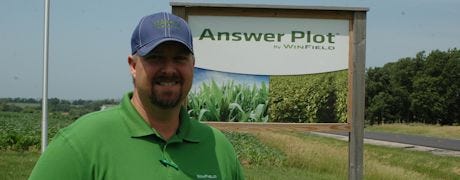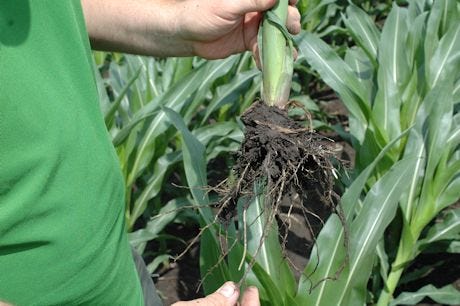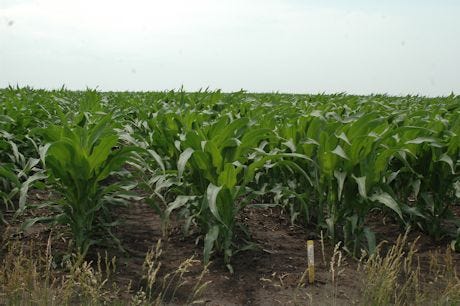
With 200 locations across North America, within an hour's drive of most farmers, the WinField Answer Plot system is intended to be relevant to the areas they are in. "We want to try to get them as local as possible," says Heath Peterson, seed agronomy advisor at the Hiawatha plot. "We try to match up the plot with some of the practices that are consistent to that area."

INFLUENCING LOCAL FARMERS: Seed agronomy advisor at WinField's Answer Plot in Hiawatha, Heath Peterson says in addition to the plot being influenced by practices in the area, local farmers are adopting management practices after seeing how they have worked in the plot. "They're looking at how they can give that plant nutrition when it really needs it," Peterson says. "They are implementing those things into their own farm and those are the kinds of things that are really fun to see."
The crews experience the same issues farmers do. They use satellite imagery to detect things like frost and wind damage. "There are always things that go on out there like wet spots that can give us issues," Peterson says. This year, when farmers planted late due to the cold, wet weather, the crew at the 20-acre Hiawatha, Kansas plot was doing the same. They planted corn on May 17 and soybeans on June 7, juggling time with other locations. "They had a lot of miles to cover," Peterson says. "I think for the most part, farmers were also pressed to get crops planted in a timely fashion."
The Hiawatha location has 15 acres dedicated to research and 5 dedicated to demonstrations and WinField Knowledge Events. "We'll bring growers into the plot and try to give them insights into the things we're doing using products they can purchase today," Peterson explains. This involves looking at how varieties respond to nitrogen, rotation, fungicide and numerous other factors. WinField regional agronomists are available to answer questions. "It's called an Answer Plot because of that."~~~PAGE_BREAK_HERE~~~
Farmers can stop by anytime. "Our farmers will just drive out and take a look at the plot," Peterson says. "As long as people come in and are respectful, we encourage people to come in and take a look."

UNIQUE SOIL TYPES: Soil types vary greatly from one part of Kansas to another, as well as one part of Brown County to another. In this part of northeast Kansas, finer clay soils are more common than the silt loams near the Wamego plot. "We can truly give the growers that have clay soil types a taste of what products work for them," Peterson says. "There are hybrids out there that have a more aggressive, penetrating root profile, that explore clay soils much better. Those genetics are more adapted to be tough enough to grow into those tougher clays."
Wide variety of factors
One of the things farmers can see is how growth is affected by northeast Kansas's finer clay soil, compared to the silt loam closer to the Wamego plot. "We can truly give the growers that have clay soil types a taste of what products work for them," Peterson says. "There are hybrids out there that have a more aggressive, penetrating root profile, that explore clay soils much better. Those genetics are more adapted to be tough enough to grow into those tougher clays."
Kansas itself has a vast difference in soil and climate affecting yield across the state. "[In 2011] we had the highest yielding and the lowest yielding Answer Plot in our whole system just within our state."

KEEP IT LOCAL AND UNIFORM: While it's important to keep practices at the Hiawatha Answer Plot as local as possible, it's also important to make sure certain factors are uniform to ensure quality data. While the research and demo acres here have different planting populations and varieties, some factors must be alleviated. For example, terraces aren't included. "We try to get as uniform of a field as possible," Peterson says. "In Brown County, it's really hard to find 20 acres that are unterraced."
Other factors include nutrient application, plant population, row spacing, seed variety and planting depths. "We really try to dig into what makes those plants perform to the highest standard." For demo and research acres, varieties of CROPLAN are used, along with varieties of each of the partners working with WinField, including Asgrow, Dekalb (Monsanto), Mycogen (Dow), and NK (Syngenta). "We're really trying to understand how the products work and where they fit."
Four plant populations are used. With planters specially made for research, crews can plant in variable populations on the fly. The Hiawatha plot's populations vary from 24,000, 30,000, 36,000 and 42,000. "Growers can see how a specific population affects stalk growth and root mass," Peterson says. "In most cases, we don't see a detriment to yield pushing population." Of course, growers still need to follow up with proper nutrient application. "It's a ripple effect of the things you've got to think about."~~~PAGE_BREAK_HERE~~~
Acres devoted to demonstrations and research use different nitrogen scenarios to see how certain varieties respond. This is usually separated by a silver label for the average nitrogen scenario, and a gold label for a luxury nitrogen scenario. Nutrient application requires proper placement where and when they are needed. In the early life cycle of corn, zinc is applied. Later, nitrogen, potassium and sulfur are applied in the V7 to V10 stages. "We're really trying to target nutrient applications when the plant needs it," Peterson says.
Uniform data is important
Some factors must be alleviated to keep data uniform. For example, terraces aren't included. "We try to get as uniform of a field as possible," Peterson says. "In Brown County, it's really hard to find 20 acres that are unterraced." In addition, other changes might require the system to adapt. Most sites in the U.S. use 30-inch rows for corn. "As growers are adapting and having twin rows and 20-inch rows, that's a challenge for our system to meet."
Having uniform data is important, because all of the data is fed back into the R7 tool, which stands for:
*The Right Genetics for
*The Right Soil Type at
*The Right Plant Population in
*The Right Cropping System with
*The Right Traits fed
*The Right Plant Nutrition defended with
*The Right Crop Protection
"In winter when growers are making these decisions, they can go online and look at yield differences," Peterson says. "They can put that to work on their own farm."
After seeing how certain strategies have worked, farmers in the area have adapted certain management practices. "They're looking at how they can give that plant nutrition when it really needs it," he says. "They are implementing those things into their own farm and those are the kinds of things that are really fun to see."
About the Author(s)
You May Also Like






